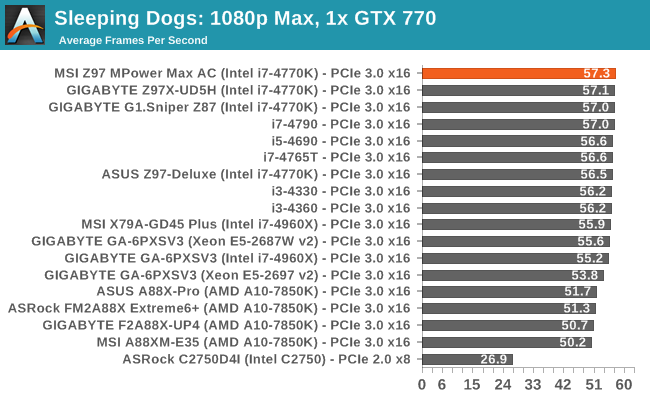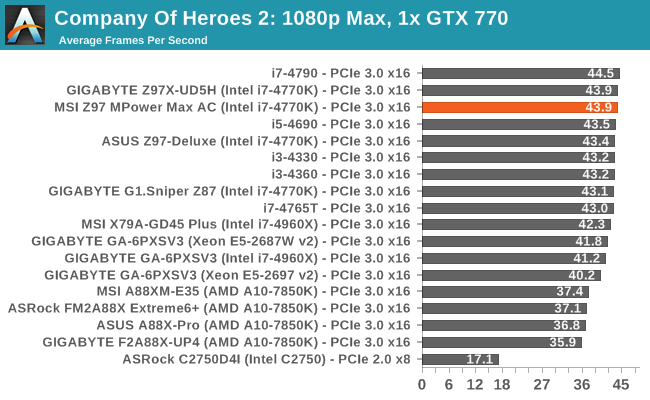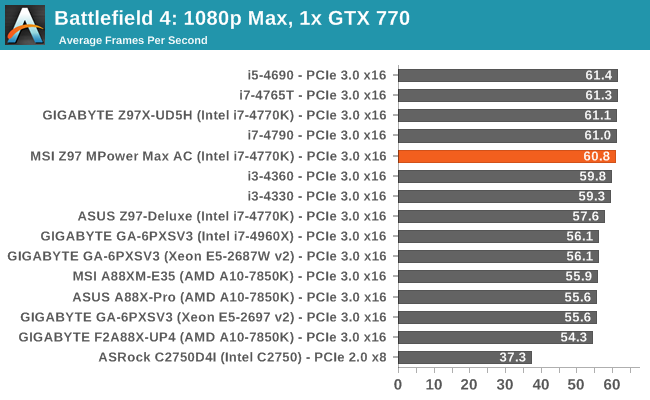MSI Z97 MPower Max AC Review: Overclocking for $260
by Ian Cutress on May 20, 2014 12:00 AM EST- Posted in
- Motherboards
- MSI
- Z97
Gaming Benchmarks
Sleeping Dogs
Sleeping Dogs is a benchmarking wet dream – a highly complex benchmark that can bring the toughest setup and high resolutions down into single figures. Having an extreme SSAO setting can do that, but at the right settings Sleeping Dogs is highly playable and enjoyable. We run the basic benchmark program laid out in the Adrenaline benchmark tool, and the Xtreme (1920x1080, Maximum) performance setting, noting down the average frame rates and the minimum frame rates.

| Sleeping Dogs, 1080p Max | ||
| NVIDIA | AMD | |
| Average Frame Rates |
|
|
| Minimum Frame Rates |
|
|
Company of Heroes 2
Company of Heroes 2 also can bring a top end GPU to its knees, even at very basic benchmark settings. To get an average 30 FPS using a normal GPU is a challenge, let alone a minimum frame rate of 30 FPS. For this benchmark I use modified versions of Ryan’s batch files at 1920x1080 on High. COH2 is a little odd in that it does not scale with more GPUs with the drivers we use.

| Company of Heroes 2, 1080p Max | ||
| NVIDIA | AMD | |
| Average Frame Rates |
|
|
| Minimum Frame Rates |
|
|
Battlefield 4
The EA/DICE series that has taken countless hours of my life away is back for another iteration, using the Frostbite 3 engine. AMD is also piling its resources into BF4 with the new Mantle API for developers, designed to cut the time required for the CPU to dispatch commands to the graphical sub-system. For our test we use the in-game benchmarking tools and record the frame time for the first ~70 seconds of the Tashgar single player mission, which is an on-rails generation of and rendering of objects and textures. We test at 1920x1080 at Ultra settings.

| Battlefield 4, 1080p Max | ||
| NVIDIA | AMD | |
| Average Frame Rates |
|
|
| 99th Percentile Frame Rates |
|
|













19 Comments
View All Comments
Haravikk - Tuesday, May 20, 2014 - link
I think the choices made here are pretty sensible; I mean, while I do hope that SATA Express does take off, it's not as if PCIe card type storage is going to just disappear, and this motherboard has plenty of room for one or two of those, so if you do want the best speeds it's not like you're forced to adopt SATAe.In fact, personally I prefer drives mounted in or near the PCIe slots now anyway, particularly for air-cooled systems, as it means more space for front fans blasting air back onto the PCIe cards, especially for cases with removable drive cages (and even on those that don't, an electric drill can soon make them removable too ;).
That said, I think they've still gone a bit too overboard on connectivity; anyone using more than four USB ports really should be considering what they're actually using them for and whether they need them, so four on the back plus headers for front ports is IMO plenty. Also, the addition of two external wireless aerials is ugly; anyone serious about performance shouldn't be using wireless networking to connect a system, not when ethernet is easy to setup, or you can use 500mbps PowerLine networking instead. And who actually uses a PS/2 port anymore? Personally I'd rather see systems cut down on the number of ports and use the saved space as extra room for rear airflow, maybe even orient the RAM to take advantage of that, though it might be a bit tight on a memory slot board, unless they gave up a PCIe slot. But then that said, who actually uses seven PCIe slots?
I think there's still a lot that performance motherboards could sacrifice in order to really focus on performance.
Ian Cutress - Tuesday, May 20, 2014 - link
I've actually received emails in the past week about a review where I didn't mention the *lack* of a PS/2 port. It offers some advantages for keyboard enthusiasts over USB, hence why a lot of mechanical keyboards come with PS/2 or USB options depending on what system it is for or who is using it.I think I'm using at least 7 USB ports on my system right now. A USB stick, two charging cables, a mouse, a keyboard that requires two (one for function, another for power) and a webcam. I've also had reasons to use multiple PCIe slots.
The reason why motherboard manufacturers include all of this is so the number of people who can use the product increases. If you limit the number of a certain feature, then you lose potential sales. It is a delicate balance between focus and inclusion. Focus may be fun, but without sales that line will die off pretty quickly.
Achaios - Tuesday, May 20, 2014 - link
Why isn't the ASUS Maximus VI Hero ROG motherboard included in the comparison? I am a membger at Overclock.net, and it seems that almost everyone who owns a 4770k pairs it with a Maximus VI Hero.alhopper - Tuesday, May 20, 2014 - link
It's great to see innovation is still alive and kicking with this motherboard. Why didn't they include the Z97 chipset in the water cooling loop? Does the z97 run cooler than previous Intel chipsets?magnusmundus - Tuesday, May 20, 2014 - link
Is there any way to remove the barbs so you could add your own water cooling fittings? Looking at the photos I don't see any wrench flats.C.C. - Wednesday, May 21, 2014 - link
Sadly, these are "fixed" barbs, meaning they are soldered in place to the most likely aluminum tubing that runs through the VRM heatsink. This is bad since I don't know anyone building custom loops that use tiny 3/8" barbs anymore (this isn't 2006). I personally use 7/16" Compression fittings myself..The other issue is that of mixed metals. I run an all copper block loop, and if MSI opted to cheapen out and use aluminum instead of copper for the water tubing (much like Asus and Gigabyte have done in the past) then there is a very real issue of corrosion issues cropping up. Ian, can you please get ahold of MSI and find out if they are using aluminum or copper?
AnnihilatorX - Wednesday, May 21, 2014 - link
Page 1: "The manual overclocking was very conservative, with OC Genie boosting the CPU to 4.0 GHz only. I would have preferred a 4.2 GHz minimum overclock here at least."I think you meant the automatic overclocking!
mkygod - Tuesday, May 27, 2014 - link
Anyone here looked at the motherboard box cover and automatically thought of the Metro: Last Light box cover?eanazag - Wednesday, May 28, 2014 - link
Being that is has an Intel WiFi card, would I be correct to assume it supports WiDi (wireless display)?